Ver-sur-Mer Sexton SPG
Towed artillery had problems keeping up with fast moving tanks. They also took a long time to set up. The answer was to put an artillery gun on top of a tank chassis. The Sexton is a 25pdr (87.6 mm) gun fitted on top of a Canadian built M4 Grizzly Sherman. Early versions used the Ram M3 Lee tank chassis.
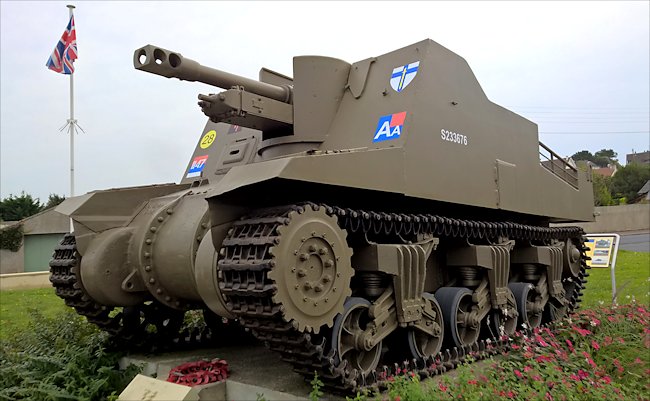
D-Day Gold Beach Memorial Sexton self-propelled 25pdr artillery gun tank
Location
This British 25pdr Sexton self-propelled artillery gun is easy to find. It is placed in a memorial square along the main Normandy Gold Beach coast road the D514 Route d'Asnelles where it meets the Avenue du 6 Juin, in the D-Day town of Ver-sur-Mer. The junction is controlled by traffic lights. Turn into the Avenue du 6 Juin to access the memorial's car park behind the Sexton.
The memorial square is called Espace Robert Kiln in honour of Major Robert Kiln who took part in the D-Day landings with the 86th Field Regiment Royal Artillery on Gold Beach, K for King sector. The Sexton Slef-propelled artillery gun was presented to the town of Ver-sur-Mer by the major's son Dr Mathew Kiln in memory of his father and all the British troops who landed on Gold Beach on 6th June 1944 and the days that followed.
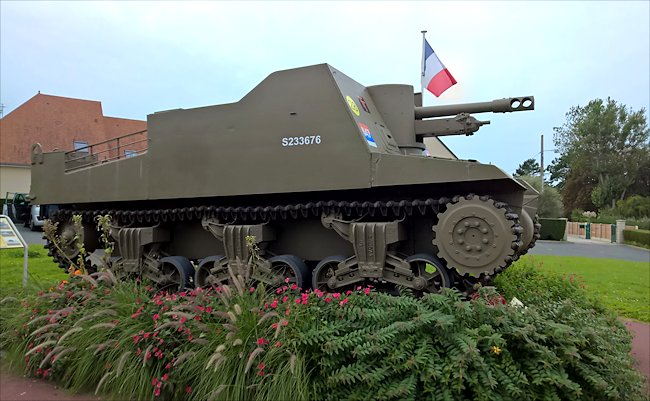
This sexton is built on a Canadian Grizzly M4 Sherman tank chassis
Specification
It was powered by a petrol Continental R-975 9 cylinder radial engine that produced 400 hp. The Sexton had a top road speed of 25 mph (40 km/h). It was not designed to fight tanks in close combat. Its armour thickness ranged from 15 mm to 32mm which was just strong enough to protect the crew from small arms fire and hot jagged shrapnel from exploding artillery and mortar shells. many of the Sextons were fitted with wading screens to prevent them being flooded by large waves as they waded ashore. These screens were taken off once they had got off the beach.
It needed a gun crew of 6; Commander, driver, gunner, gun-layer, loader, radio operator. The main gun was a British Ordnance QF 25 pounder Mk II. Around 105 high explosive HE shells could be stored onboard. These weighed 25 lbs each (11kg). This is how the gun got its name. A few of the shells would be armour piercing AP rounds for self defence just incase a German panzer surprised their location and smoke shells. It was capable of firing indirectly at targets 7.61 miles (12.25 km) away. The crew had access to two 0.303 (7.70mm) light Bren machine guns
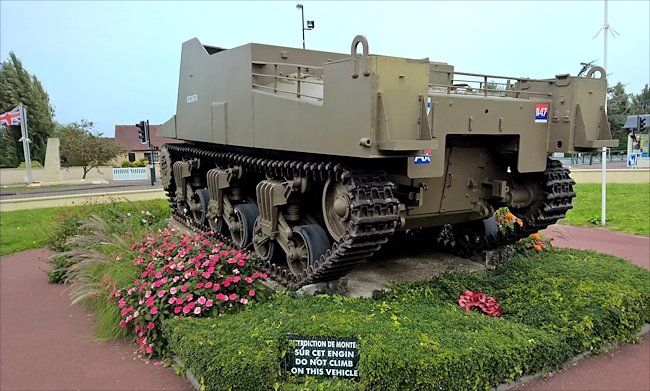
Rear view of the Ver-sur-Mer Sexton looking out towards Gold Beach
86th (Hertfordshire Yeomanry) Field Regiment, Royal Artillery
The regiment landed on Gold Beach. It was a Territorial ( part-time volunteer reserve) unit which mobilised with towed guns in 1939 and converted to self-propelled in 1943. Their guns engaged targets from the landing craft approaching Gold Beach and forward observer parties from the regiment accompanied each assault infantry battalion, ready to give fire support as soon as the guns came into action on land.
From their position at the back of the fleet of landing craft approaching King Sector, the guns of 89th Field Regiment opened fire on their first target — the beach at La Riviere — 35 minutes before H-hour (H-35) at a range of more than 12,000 yards (11.000 metres).They continued firing at four rounds a minute until H-7, when fire was transferred to the heavily fortified area around the lighthouse for a further twenty minutes.
The landing craft then turned round and waited a short distance out to sea until called back to the beach. The first three troops to land twelve guns in all — came into action on the beach soon after 08.30 and began firing at once, directed by forward observers with the leading infantry, who were now some three miles (5 kms) inland.
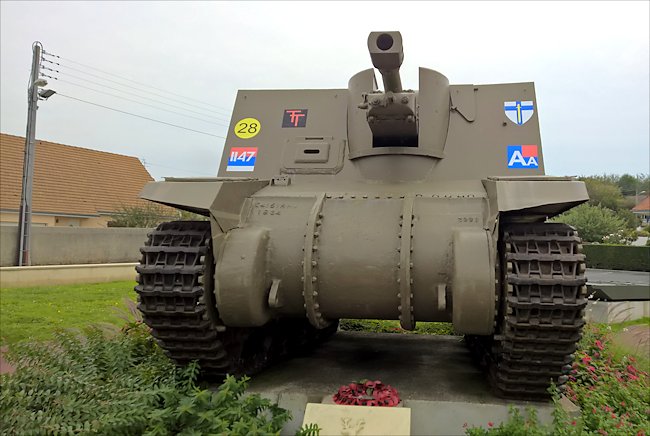
This sexton's 25 pdr gun is fitted with a muzzle brake to increase the life of the gun barrel and reduce recoil.
What do the badges signify?
On the right of the sexton you will see a Regimental badge with two capital letter A's. This sign indicates the function of a vehicle within its own unit. The small red square denotes the senior battery of the regiment. The large A represents A Troop and the small A the senior gun of the troop. The yellow circle with the number 28 in the middle indicates the weight of the vehicle and that it can only drive over bridges that are rated to be able to carry 28 tonne vehicles safely. The Square badge below it with the numer 1147 is the assigned number for the 86th Field regiment. It is placed on a red-and-blue background, denoting artillery, above a white bar, which denotes Army Troops.
The white shield badge with the blue cross and sword is the Formation Badge for the 2nd Army. The 86th Field Regiment belonged to a pool of units at the disposal of Headquarters Second Army, known as 'Second Army Troops'. The regiment could be allocated to any division requiring additional self-propelled artillery for a particular operation. The badge with the two red letter T's was for the 50th Infantry Division. For the assault on Gold Beach, 86th Field Regiment was placed under command of 50th Division. It was originally raised in North-East England. The two letter Ts in the badge represent the main rivers of the area — the Tyne and the Tees.
The Porpoise ammunition tank sledge
This is a very rare piece of military equipment that has survived the D-Day beach clear ups. It is called a 'Porpoise' and is an extra ammunition sledge. The planners' concern that tanks and self-propelled artillery guns like the Sexton, in the first assault waves might run out of ammunition at an early stage led to the idea that they could themselves bring additional supplies ashore. Reserve stocks would then be available long before wheeled ammunition vehicles could each the beaches. By April 1944 it had been decided that assaulting tanks would drag their extra ammunition ashore in a sealed, submersible container, for all practical purposes a sledge, which was given the name 'Porpoise'.
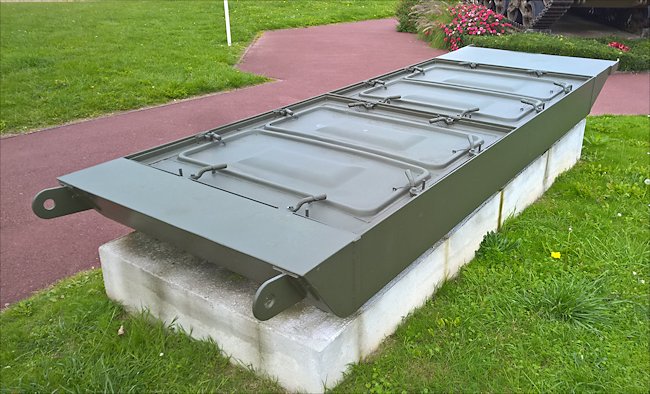
This sledge was towed behind tanks and Sexton SPG through the surf. It carried extra shells.
There were two models, the larger one of which was capable of carrying approximately the same amount of ammunition, for main armament and machine-guns as could be stowed inside the tank. Self-propelled artillery units, both field and anti-tank, were also equipped with Porpoise sledges to increase the amount of ammunition available in the early stages of the battle.
Most units intended that tanks or guns would deposit their porpoises at a preplanned site. The waterproofing seals would be removed and the contents stacked together to make the units first ammunition point, from which ammunition could be distributed to those tanks and self-propelled artillery guns that needed it most. It must be said however that this did not always happen. The porpoise sledges did not run well on metaled road or hardened tracks. The commanders of self-propelled guns like the Sexton, were especially often tempted to use any delay in reaching the beach exits to unload their porpoises as fast as they could and carry the extra ammunition on the gun.
Both models of porpoise sledges were used on the day. The one shown in the photograph on display at Ver-sur-Mer is the No.2 porpoise which is the larger version. The hull of the sledge is a modern reconstruction to which have been fitted doors and other parts which were found in relatively good condition on local farms nearly 70 years after the landings.
Gold Beach
Once you have finished looking around the Sexton SPG cross the main road and drive along the Voie du Debarquement road. It will take you to the Gold Beach landing zone. Back track afterwards and turn left onto the Boulevard de la Plage to explore that part of the beach.
D-Day 1944 books

